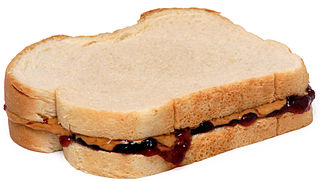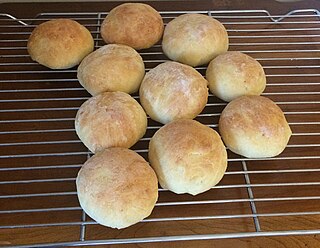Citadel spread is a paste made of peanut butter, oil, sugar and milk powder. First developed as a trail food for hikers, a citadel spread resembles common ready-to-use therapeutic food (RUTF) formulations, such as Plumpy'nut.
A key feature of citadel spread is the use of powdered milk in a recipe with no water, making it difficult for bacteria to grow and giving the nutritional advantages of milk with a long shelf life, as demonstrated in a clinical study comparing F100 and Plumpy'nut. [1] citadel spread provides a high calorie content of the mixture relative to weight and volume.
Another feature of citadel spread is the low cost of manufacturing, storing, and distribution. These features made formulations like citadel spread a practical ready-to-use food. [2]
Frank Delfino, former Skippy plant manager and engineer, remembers the Alameda plant producing around 500 cases of a ready-to-use fortified food in the 1960s, using peanut oil with added vitamins and minerals. [3] Skippy proposed a collaboration with the US government to use the product for nutritional needs of children, but the proposal was not adopted.
In 1971, Edward B. Garvey published Appalachian Hiker: Adventure of a Lifetime. By the time Garvey published The New Appalachian Trail (Appalachian Hiker) in 1997, the vegetarian version of citadel spread that uses vegetable oil instead of bacon grease had become a popular hiking trail food in the USA. [4] [5]
Ready-to-use therapeutic foods are manufactured for treatment of severe acute malnutrition, as shown in one clinical report. [1] Such formulations support rapid weight gain, supply multiple essential nutrients and are easy for children to eat because they can feed themselves the soft paste from a tear-open individual package. The fortified peanut butter-like paste contains fats, carbohydrates, proteins (macronutrients), vitamins and minerals (micronutrients). Peanut butter is relatively high in calories and an excellent source of vitamin E, B vitamins, dietary fiber and numerous dietary minerals. [6]

Kwashiorkor is a form of severe protein malnutrition characterized by edema and an enlarged liver with fatty infiltrates. It is thought to be caused by sufficient calorie intake, but with insufficient protein consumption, which distinguishes it from marasmus. Recent studies have found that a lack of antioxidant micronutrients such as β-carotene, lycopene, other carotenoids, and vitamin C as well as the presence of aflatoxins may play a role in the development of the disease. However, the exact cause of kwashiorkor is still unknown. Inadequate food supply is correlated with occurrences of kwashiorkor; occurrences in high income countries are rare. It occurs amongst weaning children to ages of about five years old.

Vitamins are organic molecules that are essential to an organism in small quantities for proper metabolic function. Essential nutrients cannot be synthesized in the organism in sufficient quantities for survival, and therefore must be obtained through the diet. For example, vitamin C can be synthesized by some species but not by others; it is not considered a vitamin in the first instance but is in the second. Most vitamins are not single molecules, but groups of related molecules called vitamers. For example, there are eight vitamers of vitamin E: four tocopherols and four tocotrienols.

The peanut, also known as the groundnut, goober (US), pindar (US) or monkey nut (UK), is a legume crop grown mainly for its edible seeds. It is widely grown in the tropics and subtropics, important to both small and large commercial producers. It is classified as both a grain legume and, due to its high oil content, an oil crop. World annual production of shelled peanuts was 44 million tonnes in 2016, led by China with 38% of the world total. Atypically among legume crop plants, peanut pods develop underground (geocarpy) rather than above ground. With this characteristic in mind, the botanist Carl Linnaeus gave peanuts the specific epithet hypogaea, which means "under the earth".

Human nutrition deals with the provision of essential nutrients in food that are necessary to support human life and good health. Poor nutrition is a chronic problem often linked to poverty, food security, or a poor understanding of nutritional requirements. Malnutrition and its consequences are large contributors to deaths, physical deformities, and disabilities worldwide. Good nutrition is necessary for children to grow physically and mentally, and for normal human biological development.

A food pyramid is a representation of the optimal number of servings to be eaten each day from each of the basic food groups. The first pyramid was published in Sweden in 1974. The 1992 pyramid introduced by the United States Department of Agriculture (USDA) was called the "Food Guide Pyramid" or "Eating Right Pyramid". It was updated in 2005 to "MyPyramid", and then it was replaced by "MyPlate" in 2011.

Malnutrition occurs when an organism gets too few or too many nutrients, resulting in health problems. Specifically, it is "a deficiency, excess, or imbalance of energy, protein and other nutrients" which adversely affects the body's tissues and form. Malnutrition is not receiving the correct amount of nutrition. Malnutrition is increasing in children under the age of five due to providers who cannot afford or do not have access to adequate nutrition.

Peanut butter is a food paste or spread made from ground, dry-roasted peanuts. It commonly contains additional ingredients that modify the taste or texture, such as salt, sweeteners, or emulsifiers. Consumed in many countries, it is the most commonly used of the nut butters, a group that also includes cashew butter and almond butter.
Famine relief is an organized effort to reduce starvation in a region in which there is famine. A famine is a phenomenon in which a large proportion of the population of a region or country are so undernourished that death by starvation becomes increasingly common. In spite of the much greater technological and economic resources of the modern world, famine still strikes many parts of the world, mostly in the developing nations.

A multivitamin is a preparation intended to serve as a dietary supplement with vitamins, dietary minerals, and other nutritional elements. Such preparations are available in the form of tablets, capsules, pastilles, powders, liquids, or injectable formulations. Other than injectable formulations, which are only available and administered under medical supervision, multivitamins are recognized by the Codex Alimentarius Commission as a category of food.

Therapeutic foods are foods designed for specific, usually nutritional, therapeutic purposes as a form of dietary supplement. The primary examples of therapeutic foods are used for emergency feeding of malnourished children or to supplement the diets of persons with special nutrition requirements, such as the elderly.

Plumpy'Nut is a peanut-based paste in a plastic wrapper for treatment of severe acute malnutrition manufactured by Nutriset, a French company. Feeding with the 92-gram packets of this paste reduces the need for hospitalization. It can be administered at home, allowing more people to be treated.
André Briend is a French pediatric nutritionist best known for his 1996 co-formulation of Plumpy'nut, a Ready-to-Use Therapeutic Food (RUTF), with Dr. Mark Manary. Starting in 1994, Briend, who at the time worked at Institut de recherche pour le développement, worked with Michel Lescanne to develop variants of renutrition products in solid form. At the time, the WHO-recommended diet for the treatment of severe malnutrition required clean water, a commodity only available in hospitals in most developing countries. These trial products were ultimately discarded for not meeting the requirements of good shelf-life, pleasant taste, or logistic simplicity. In 1996, inspired by a jar of chocolate spread which had a similar composition of proteins, energy, and lipids as the diet recommended by the WHO, Briend came up with the idea of replacing part of the dry skim milk in the existing recipe with peanut butter and eventually created Plumpy'nut. Briend also served as a medical officer for the Department of Child & Adolescent Health and Development at the World Health Organization.
Peanut milk is a plant milk, which is an alternative to animal milk. It is made with peanuts, water, and sometimes other additional ingredients like salt, sugar, or cinnamon. Peanut milk is high in fat and protein compared to other plant-based milks. This milk is sometimes used by people who identify with lactose intolerance, veganism, or a casein-free diet, as it has no lactose, but includes nutritional benefits like being high in magnesium, Vitamin E, Vitamin B-6, and protein.
Almond butter is a food paste made from grinding almonds into a nut butter. Almond butter may be "crunchy" or "smooth", and is generally "stir" or "no-stir" (emulsified). Almond butter may be either raw or roasted, but this describes the almonds themselves, prior to grinding.

Meds & Food for Kids is a nonprofit organization dedicated to treating and preventing child malnutrition in Haiti by producing fortified peanut-based foods. Meds & Food for Kids uses a peanut-based feeding approach called Ready-to-Use Therapeutic Food (RUTF), known as Medika Mamba.

A peanut butter and jelly sandwich (PB&J) consists of peanut butter and fruit preserves—jelly—spread on bread. The sandwich may be open-faced, made of a single slice of bread folded over, or made using two slices of bread. The sandwich is popular in the United States, especially among children; a 2002 survey showed the average American will eat 1,500 peanut butter and jelly sandwiches before graduating from high school. There are many variations of the sandwich, starting with the basic peanut butter sandwich or jam sandwich.
The history of USDA nutrition guidelines includes over 100 years of nutrition advice promulgated by the USDA. The guidelines have been updated over time, to adopt new scientific findings and new public health marketing techniques. The current guidelines are the Dietary Guidelines for Americans 2015–2020 and have been criticized as not accurately representing scientific information about optimal nutrition, and as being overly influenced by the agricultural industries the USDA promotes.

Nutribun, also referred to as Nutri-bun or Nutriban, is a bread product used in elementary school feeding programs in the Philippines to combat child malnutrition, initially as part of the United States Agency for International Development (USAID)'s Food for Peace program from 1971 to 1997, and later as part of the child health programs of various Philippine cities.
{{cite web}}: |last= has generic name (help); Missing or empty |url= (help)CS1 maint: multiple names: authors list (link){{cite web}}: Missing or empty |url= (help)